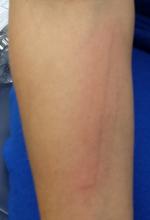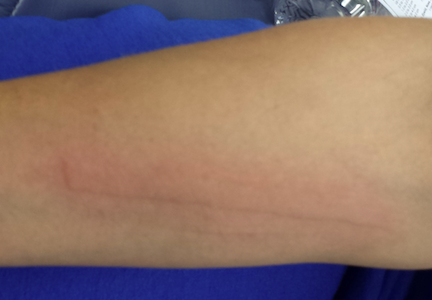User login
A 41-year-old man complains of “red lines” that appear on his skin soon after minor scratching trauma. They manifest rapidly but disappear within minutes (occasionally as long as an hour), leaving no trace. They cause no symptoms but are nonetheless disturbing to the patient.
In terms of his overall health, the patient has few problems beyond mild seasonal allergies. However, he reports experiencing a great deal of stress recently. He denies taking any prescription medications regularly, though in the spring, he often takes OTC antihistamines to ward off sneezing and itchy eyes.
EXAMINATION
A linear wheal appears after the skin is scratched with the dull edge of a fingernail. The initial reaction to the scratch is a macular red flare, followed within seconds by a broadening band of erythema. Seconds later, the frank wheal appears. The lesion is warmer than the surrounding skin but not at all tender. As expected, it clears completely within a few minutes, leaving no sign of its ever having been there.
On the next page: Diagnosis and Joe Monroe's Discussion >>
DISCUSSION
This form of urticaria is called dermatographism (literally, “skin writing”) and is of unknown origin. It affects 2% to 5% of the population. Most affected patients are asymptomatic, although perhaps 10% of them will report itching and burning. This condition exhibits neither gender nor race bias.
Dermatographism is the most common form of the physical urticarias, which can also be caused by pressure, cold, and vibration. The speed with which the wheal forms is remarkable and unique to histamine-mediated conditions, though the exact mechanism is debatable. (Its three-stage formation is collectively referred to as the triple response of Lewis.) One theory holds that the trauma of scratching provokes an antigen to interact with mast cell bound IgE, triggering the release of inflammatory mediators (eg, histamine, bradykinins, or leukotrienes). Bolstering this theory is the observation that 75% of patients with hypereosinophilic syndrome have dermatographism.
Dermatographism effectively confirms the presence of traditional urticaria, itself more common in atopic patients. The rapidity of the appearance and disappearance of urticaria, a phenomenon termed evanescence, often presents a challenge to diagnosis until it is confirmed.
Most patients with dermatographism first note it in their second to third decade of life. When it’s congenital, symptomatic dermatographism suggests the possibility of a mast cell disorder, such as urticaria pigmentosa or systemic mastocytosis. These can be confirmed by biopsy and/or measurement of histamine in a 24-hour urine sample.
TAKE-HOME LEARNING POINTS
• Dermatographism is an extremely common form of physical urticaria.
• It is asymptomatic in the majority of cases and disappears on its own in minutes to hours.
• It can herald the presence of more serious chronic symptomatic urticaria.
• The rapid appearance of the linear wheal and its subsequent rapid disappearance, termed evanescence, are unique to urticarial disorders.
• The phenomena by which the initial red linear flare widens quickly before forming the evanescent linear wheal are collectively known as the “triple response of Lewis.”
A 41-year-old man complains of “red lines” that appear on his skin soon after minor scratching trauma. They manifest rapidly but disappear within minutes (occasionally as long as an hour), leaving no trace. They cause no symptoms but are nonetheless disturbing to the patient.
In terms of his overall health, the patient has few problems beyond mild seasonal allergies. However, he reports experiencing a great deal of stress recently. He denies taking any prescription medications regularly, though in the spring, he often takes OTC antihistamines to ward off sneezing and itchy eyes.
EXAMINATION
A linear wheal appears after the skin is scratched with the dull edge of a fingernail. The initial reaction to the scratch is a macular red flare, followed within seconds by a broadening band of erythema. Seconds later, the frank wheal appears. The lesion is warmer than the surrounding skin but not at all tender. As expected, it clears completely within a few minutes, leaving no sign of its ever having been there.
On the next page: Diagnosis and Joe Monroe's Discussion >>
DISCUSSION
This form of urticaria is called dermatographism (literally, “skin writing”) and is of unknown origin. It affects 2% to 5% of the population. Most affected patients are asymptomatic, although perhaps 10% of them will report itching and burning. This condition exhibits neither gender nor race bias.
Dermatographism is the most common form of the physical urticarias, which can also be caused by pressure, cold, and vibration. The speed with which the wheal forms is remarkable and unique to histamine-mediated conditions, though the exact mechanism is debatable. (Its three-stage formation is collectively referred to as the triple response of Lewis.) One theory holds that the trauma of scratching provokes an antigen to interact with mast cell bound IgE, triggering the release of inflammatory mediators (eg, histamine, bradykinins, or leukotrienes). Bolstering this theory is the observation that 75% of patients with hypereosinophilic syndrome have dermatographism.
Dermatographism effectively confirms the presence of traditional urticaria, itself more common in atopic patients. The rapidity of the appearance and disappearance of urticaria, a phenomenon termed evanescence, often presents a challenge to diagnosis until it is confirmed.
Most patients with dermatographism first note it in their second to third decade of life. When it’s congenital, symptomatic dermatographism suggests the possibility of a mast cell disorder, such as urticaria pigmentosa or systemic mastocytosis. These can be confirmed by biopsy and/or measurement of histamine in a 24-hour urine sample.
TAKE-HOME LEARNING POINTS
• Dermatographism is an extremely common form of physical urticaria.
• It is asymptomatic in the majority of cases and disappears on its own in minutes to hours.
• It can herald the presence of more serious chronic symptomatic urticaria.
• The rapid appearance of the linear wheal and its subsequent rapid disappearance, termed evanescence, are unique to urticarial disorders.
• The phenomena by which the initial red linear flare widens quickly before forming the evanescent linear wheal are collectively known as the “triple response of Lewis.”
A 41-year-old man complains of “red lines” that appear on his skin soon after minor scratching trauma. They manifest rapidly but disappear within minutes (occasionally as long as an hour), leaving no trace. They cause no symptoms but are nonetheless disturbing to the patient.
In terms of his overall health, the patient has few problems beyond mild seasonal allergies. However, he reports experiencing a great deal of stress recently. He denies taking any prescription medications regularly, though in the spring, he often takes OTC antihistamines to ward off sneezing and itchy eyes.
EXAMINATION
A linear wheal appears after the skin is scratched with the dull edge of a fingernail. The initial reaction to the scratch is a macular red flare, followed within seconds by a broadening band of erythema. Seconds later, the frank wheal appears. The lesion is warmer than the surrounding skin but not at all tender. As expected, it clears completely within a few minutes, leaving no sign of its ever having been there.
On the next page: Diagnosis and Joe Monroe's Discussion >>
DISCUSSION
This form of urticaria is called dermatographism (literally, “skin writing”) and is of unknown origin. It affects 2% to 5% of the population. Most affected patients are asymptomatic, although perhaps 10% of them will report itching and burning. This condition exhibits neither gender nor race bias.
Dermatographism is the most common form of the physical urticarias, which can also be caused by pressure, cold, and vibration. The speed with which the wheal forms is remarkable and unique to histamine-mediated conditions, though the exact mechanism is debatable. (Its three-stage formation is collectively referred to as the triple response of Lewis.) One theory holds that the trauma of scratching provokes an antigen to interact with mast cell bound IgE, triggering the release of inflammatory mediators (eg, histamine, bradykinins, or leukotrienes). Bolstering this theory is the observation that 75% of patients with hypereosinophilic syndrome have dermatographism.
Dermatographism effectively confirms the presence of traditional urticaria, itself more common in atopic patients. The rapidity of the appearance and disappearance of urticaria, a phenomenon termed evanescence, often presents a challenge to diagnosis until it is confirmed.
Most patients with dermatographism first note it in their second to third decade of life. When it’s congenital, symptomatic dermatographism suggests the possibility of a mast cell disorder, such as urticaria pigmentosa or systemic mastocytosis. These can be confirmed by biopsy and/or measurement of histamine in a 24-hour urine sample.
TAKE-HOME LEARNING POINTS
• Dermatographism is an extremely common form of physical urticaria.
• It is asymptomatic in the majority of cases and disappears on its own in minutes to hours.
• It can herald the presence of more serious chronic symptomatic urticaria.
• The rapid appearance of the linear wheal and its subsequent rapid disappearance, termed evanescence, are unique to urticarial disorders.
• The phenomena by which the initial red linear flare widens quickly before forming the evanescent linear wheal are collectively known as the “triple response of Lewis.”

